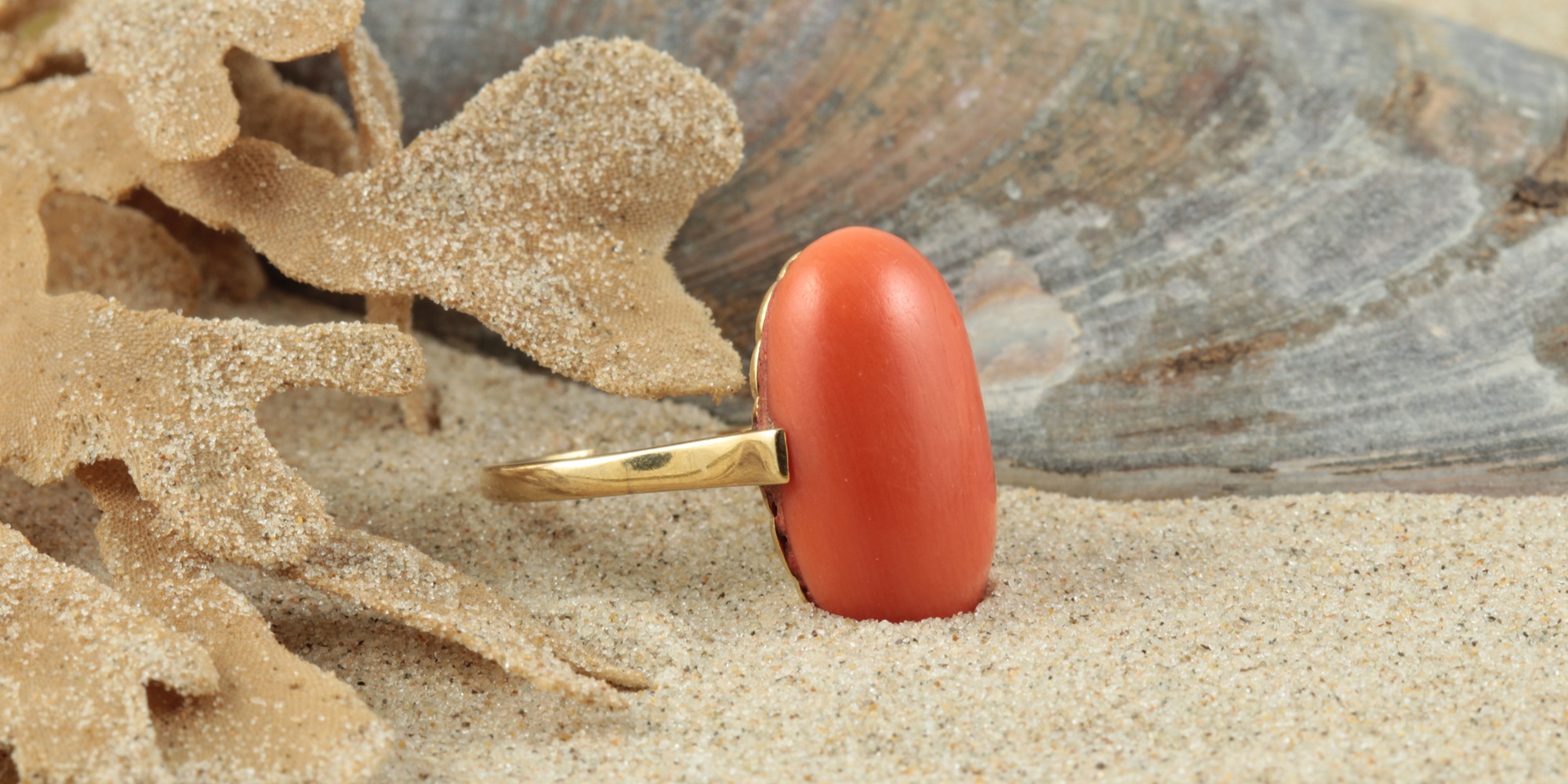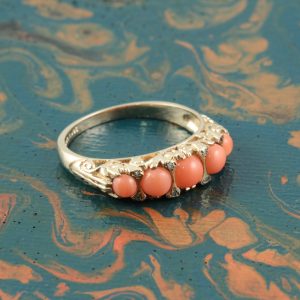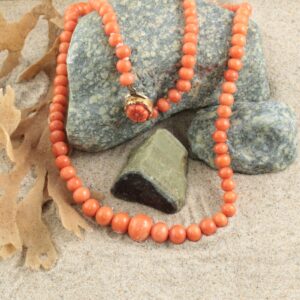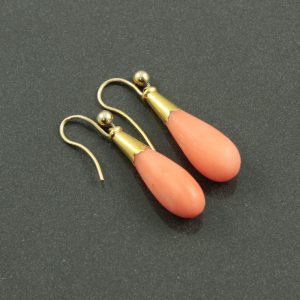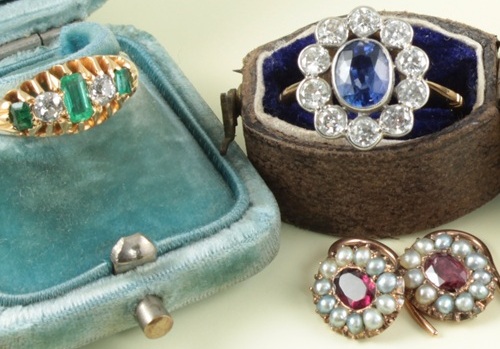Coral
The name coral is derived from the Latin word “Corallium”. The name can also be traced back to the Greek word “Korallion” which means hard skeleton. Coral belongs to the organic gemstone group, other well-known gemstones in this group include Amber and Pearl. It is made of calcium carbonate ( CaCO3 ) and grows in a branching skeleton-like structure. The branches tend to be about 8 to 10 inches long and can be up to 2.5 inches in width. It can come in a wide variety of colours but for jewellery-grade specimens, Precious Coral ( also known as Noble Coral ) the colours are red, pink, and white. There are shades of these colours produced naturally, for example, peach and orange. However, these shades are less commonly found in nature. Red Precious Coral ( Corallium Rubrum ) is the most desired of all the varieties. In its natural form, Coral is dull. It is typically polished using fine emery or sandstone, then finely polished using felt-wheels. After which it has a vitreous luster.
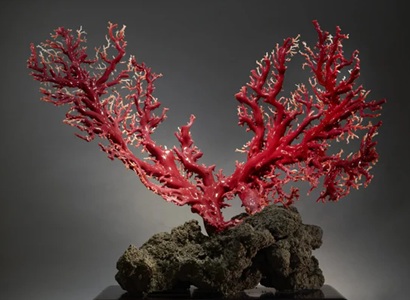 Formation: Coral is formed by small marine animals called polyps, typically on rocky seabeds in darkened environments such as crevices or caverns. These tiny marine invertebrates are soft-bodied and to protect themselves they secrete a hard exoskeleton made of calcium carbonate. Polyps form colonies, as they form their exoskeletons on the rocks, they grow upwards in a branch-like formation. This process is very slow, typically about 1 millimeter of growth per year. The lifespan of an individual polyp is relatively short, about 2 to 3 years. When a polyp dies, its space is either healed over or it is then up by a new polyp and so the colony can survive for centuries. Precious Coral gets its colour from carotenoid pigments, which is produced by the polyps. There are also environmental conditions which influence the colouration. In darker, colder water, the colouration is deeper shades of red. While warmer, brighter water will result in more shades of orange.
Formation: Coral is formed by small marine animals called polyps, typically on rocky seabeds in darkened environments such as crevices or caverns. These tiny marine invertebrates are soft-bodied and to protect themselves they secrete a hard exoskeleton made of calcium carbonate. Polyps form colonies, as they form their exoskeletons on the rocks, they grow upwards in a branch-like formation. This process is very slow, typically about 1 millimeter of growth per year. The lifespan of an individual polyp is relatively short, about 2 to 3 years. When a polyp dies, its space is either healed over or it is then up by a new polyp and so the colony can survive for centuries. Precious Coral gets its colour from carotenoid pigments, which is produced by the polyps. There are also environmental conditions which influence the colouration. In darker, colder water, the colouration is deeper shades of red. While warmer, brighter water will result in more shades of orange.
Treatment: As a general rule, Precious Coral is not treated. Precious Coral naturally has a glassy vitreous lustre and durability which treated varieties do not. As such its value comes from its rarity and authenticity. However, for lower quality varieties there are a number of treatments commonly applied to improve its appearance. Dying is typically applied to Coral which is pale or has uneven colouration and so making it more vibrant. Bleaching can be used to remove dark spots or to lighten a specimen`s overall colour. Bleaching is often used to change black Coral ( which has no commercial value ) into a golden colour. Resin is used to fill fractures or imperfections to strengthen the piece and achieve a smoother surface. An overall surface coating with a polymer can also be applied to give a hardened finish. Although these treatments do improve appearance, they tend not to be permanent and over time will fade.
Durability: Coral has a hardness rating of 3 to 4 on the Mohs scale. Which makes it a soft gemstone and not recommended for everyday use, especially rings and bracelets which are prone to impacts. This gemstone is also porous, as such contact with lotions, perfumes and sunscreen etc should be avoid. When cleaning, it is best to simply use a damp soft cloth and wipe gently. Do not leave it to soak in water or come into contact with soap. Care must also be taken when storing. It should be kept seperate from other jewellery and placed in a soft cloth pouch. Away from direct sunlight or any sources of heat. Prolonged exposure to sunlight will cause the colour to fade and it to become brittle.
Meaning and Healing Properties
Coral has long symbolised joy, healing and new beginnings. It was said to protect the wearer from negative energy, help to overcome fear and to boost courage and self-confidence. This gemstone has been associated with a number of healing properties. It was said to improve blood circulation, reduce inflammation and to help with improving and maintaining bone density. It promotes fertility and offers protection to both mother and child during pregnancy.
Chakra: Coral is associated with the root chakra, which promotes grounding, stability, security and vitality. Orange coloured varieties have been associated with the sacral chakra, promoting creativity and joy.
Birthstone: Coral is not listed as a birthstone in the traditional birthstone chart. However, it can be an alternative birthstone for April.
Zodiac Astrology: Coral is most closely associated with the star sign Aries, because it is linked to Mars. It is also associated with Scorpio, Sagittarius, Cancer and Leo.
Wedding Anniversary: Coral is the traditional gift for a 35th wedding anniversary, symbolising protection, longevity and acceptance in a marriage. Emerald and Jade are also associated with a 35th wedding anniversary.
History
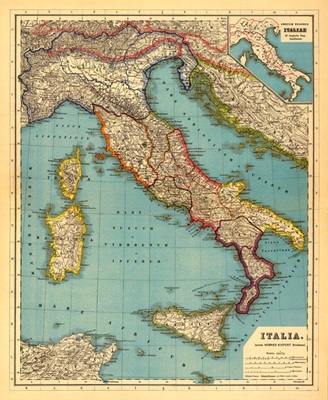 Coral and its use has a very long history, dating back thousands of years. There has been archaeological evidence found of Mediterranean Coral being used in jewellery and decorative objects in the late Neolithic period in the Alpine region. There is also evidence of its use by the Celts as far back as the 7th century BC. Historically, the main source of Coral was in the Adriatic Sea and the Tyrrhenian Sea. The harvesting of Coral was originally a simple process of collecting it as it washed ashore, typically after a storm. Or occasionally it would become entangled in fishing nets.
Coral and its use has a very long history, dating back thousands of years. There has been archaeological evidence found of Mediterranean Coral being used in jewellery and decorative objects in the late Neolithic period in the Alpine region. There is also evidence of its use by the Celts as far back as the 7th century BC. Historically, the main source of Coral was in the Adriatic Sea and the Tyrrhenian Sea. The harvesting of Coral was originally a simple process of collecting it as it washed ashore, typically after a storm. Or occasionally it would become entangled in fishing nets.
By the early 15th Century, organised harvesting was well established on the island of Zlarin in the Adriatic Sea. The islanders of Zlarin were noted to be the best coral divers in the Adriatic at the time. During this time, coral from Zlarin was sold unprocessed to workshops in Sicily, which was a major trade hub for the gemstone. As the industry grew on Zlarin, local craftsmen opened their own workshops on the island and started processing it themselves. The Republic of Venice controlled Coral diving in the Adriatic up until 1797. After the fall of the Republic of Venice, the islanders of Zlarin were granted exclusive diving rights. In the late 19th Century, the industry began to decline in Zlarin due to overharvesting and the discovery of new reefs off the coast of Sicily. Small-scale artisan processing of Coral still continues there to this day.
Torre del Greco, located near Naples in Italy, was a historically important source of Red Coral (Corallium Rubrum) and remains the dominant global hub to this day. Coral harvesting has taken place here for thousands of years, with organised harvesting beginning in the 15th Century. The people of Torre del Greco established trade associations to regulate harvesting, protect artisan craftsmen and to promote their industry. Which earned them the nickname “Corallini”. In shallower waters they would dive to harvest Coral. But in deeper water, they would dredge the seabed using a device called the “ingegro” or “St. Andrew`s Cross”. This implement was a large wooden cross, which was weighted with stones in order to sink it to the seabed. Attached to the arms of the cross were hemp nets called retazze. As the cross was dragged over the seabed, the nets would snag and pull off branches of Coral. The industry grew and by the 17th Century was a large part of the local economy, with thousands of locals engaged in the industry. During this time, the vast majority of Coral harvested in Torre del Greco was sold to other cities in Italy and France for finishing. However, this all changed in 1805 when Paolo Bartolomeo Martin set up his workshop in Torre del Greco. To help him become established, he was given a tax exemption which boosted his business and made him very successful. Martin`s tax exemption allowed him a 10-year Coral-working monopoly. In exchange, Martin agreed to train local craftsmen in the intricate art of cameo making as well as jewellery in general. This arrangement was so successful that it turned Torre del Greco into the leading global producer of finished Coral and cameos. Today it is estimated that 90% of all Coral harvested globally is processed in Torre del Greco.
Today the harvesting of Precious Coral is tightly regulated due to historic overharvesting and seabed destruction. Generally, harvesting is only permitted to scuba divers who pick only the dead Coral by hand. Destructive methods such as dredging are now banned. The main sources of jewellery-grade Coral today comes from the Mediterranean, Japan, Taiwan, Indonesia and the Philippines.
Folklore
Down through the ages, Coral has been associated with many beliefs. This gemstone was seen as a source of protection against evil spirits, sickness and misfortune. It was seen as assisting new life, blood circulation and vitality. It was considered a source of good luck, receiving it as a gift meant receiving good luck. In ancient Egypt, it was associated with divine blood and protection. There was a common practice among ancient Egyptians to place it in the tombs with the dead to protect them in the afterlife. This gemstone was highly prized by the Egyptians and wearing it was viewed as a status symbol.
Greek mythology: In Greek mythology, Perseus killed Medusa by beheading her. He then placed her head on seaweed beside the sea, in order to wash her blood from his hands. As the blood dripped from her severed head, it turned the seaweed into Red Coral. The ancient Greeks also associated Coral with Poseidon, god of the sea. Poseidon was said to live in an underwater palace, which was decorated with Coral, gemstones and sea flowers. Poseidon is sometimes depicted with Coral sprouting from his head.
The ancient Greeks believed this gemstone could offer them protection against evil and that it could be used as a treatment for poor blood circulation. Greek sailors believed it could calm the seas and protect them on their voyages.
Roman mythology: The ancient Romans associated Coral with Neptune, god of the sea. They believed Coral had the ability to calm the seas. They also believed it could cure venomous bites from snakes or scorpions. It was widely held to have protective powers, particularly for children when they wore it as a necklace. Small children would be offered a branch of Coral which was made into a rattle to use as a teething aid. The gemstone was used by Roman women to help with infertility.
The Romans traded Coral with India in return for Pearls, gemstones, spices and fine cloth. Demand was so high in India that Romans were unable to afford their own Coral. Pliny the Elder noted that Red Coral was as valuable to Indian Men as Indian Pearls were to Roman women. Pliny also complained that stocks in the Mediterranean were becoming depleted because of demand from India.
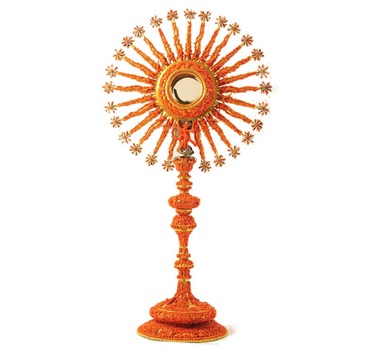 Medieval Europe: During the middle-ages in Europe, it was strongly associated with protection. It was believed to protect the wearer from malevolent forces such as witchcraft and curses. It was said to change colour to forewarn the wearer of impending sickness or danger. Medieval women wore Coral rings to help with fertility, promote vitality and for good luck.
Medieval Europe: During the middle-ages in Europe, it was strongly associated with protection. It was believed to protect the wearer from malevolent forces such as witchcraft and curses. It was said to change colour to forewarn the wearer of impending sickness or danger. Medieval women wore Coral rings to help with fertility, promote vitality and for good luck.
It was ground into a powder and used to treat conditions such as epilepsy or convulsions. Which at the time were often thought to be caused by demonic possession or some malevolent forces.
In the Catholic Church, Red Coral was associated with the Blood of Jesus Christ and his Passion. Due to its branch-like formation, it was also associated with the tree of life and the cross. It was used to decorate chalices and crucifixes, where it represented the Blood of Christ. A stunning example of which can be in this photo of a Monstrance, from 1726. It was also used in vestments and was a popular choice for rosary beads.
Famous Coral Jewellery
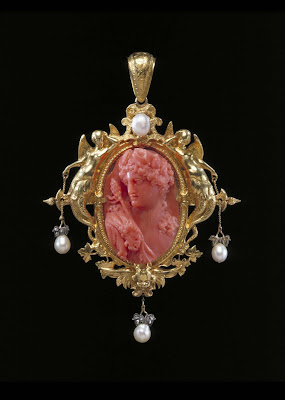
Coral Pendant, French, 1854.
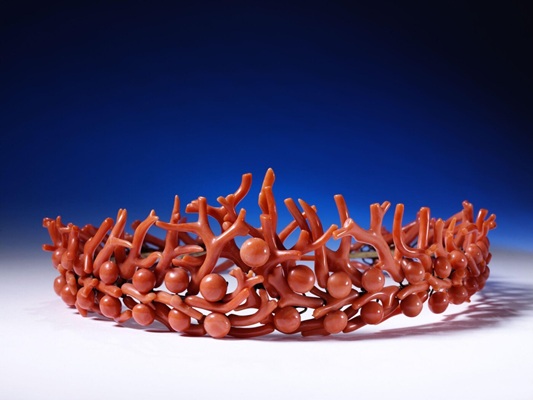
Coral Tiara.
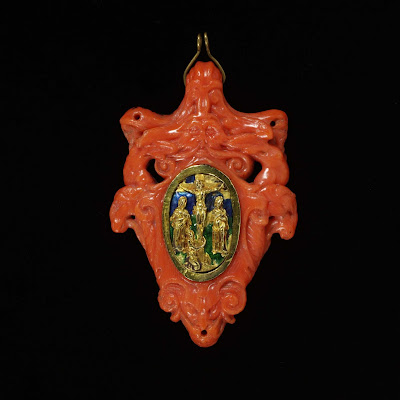
Coral pendant, Italian, 16th Century.
The above examples are on display in the V&A Museum.
Coral Gemological Data
Colour: Red, pink, white, black, blue.
Colour of Streak: White.
Moh`s hardness: 3 – 4
Density: 2.60 – 2.70 ( Red & White )
Cleavage: None.
Fracture: Irregular, splintery, brittle.
Crystal system: Trigonal.
Transparency: Translucent, opaque.
Chemical composition: Ca[CO3], organic substance.
Refractive index: 1.486 – 1.658 ( Red & White ).
Double refraction: -0.160 to -0.172 ( Red & White ).
Pleochroism: Absent.
Dispersion: None.
Fluorescence: Weak; violet.
For Researchers and Journalists: Citing This Article
Recommended Citation (MLA) Format:
Hoyne, John. “Coral: Formation, History, Meaning, and Folklore.” Carus Jewellery, n.d., https://carusjewellery.com/coral/.
You can also get in touch with Carusjewellery.com on Facebook , were you may leave any comments or questions you may have about this article.

